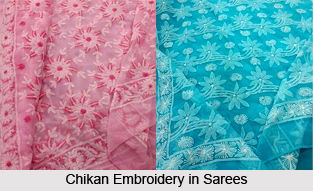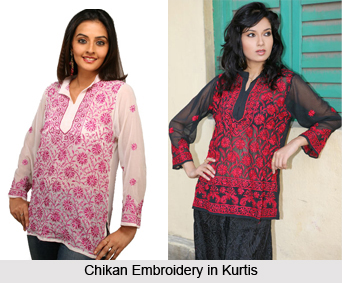 Embroidery of Uttar Pradesh carries the affluence of cultural legacy that are displayed in each form of arts and crafts of this state. The famous embroidery work of Uttar Pradesh is `Chikan` which is known for its exquisite artistic superiority all over the world. The word `chikan` is derived from the Persian word `chikaan` which means drapery.
Embroidery of Uttar Pradesh carries the affluence of cultural legacy that are displayed in each form of arts and crafts of this state. The famous embroidery work of Uttar Pradesh is `Chikan` which is known for its exquisite artistic superiority all over the world. The word `chikan` is derived from the Persian word `chikaan` which means drapery.
History of Chikan Embroidery
Chikan embroidery, the superior embroidery work of Uttar Pradesh was originated in Lucknow. There are two stories famous among the local people of this state about the origination of this particular embroidery work. It is believed that while passing through a village of Uttar Pradesh, a traveller in a hot season asked for water from Ustad Mammad Shain Khan, a farmer staying near Lucknow. Looking at his condition and the weather, the farmer said the traveller to stay in his home. Pleased with the hospitality of the farmer, the traveller promised to teach him this exclusive art. The farmer learnt ample artistic dexterity from the traveller in Chikankari art. The local people of this state believe that the traveller was sent by God.
According to the second story, the Princess of Murshidabad, married to the Nawab of Oudh, embroidered a cap for him worked with cotton thread on white muslin and presented it to him. Being jealous of her creation, the other members of her court started to compete with her and endeavoured to master this stitch. It is also believed that being influenced by Turkish embroidery, Noor Jahan may have introduced the art and since then the art had been practiced by the artisans of Uttar Pradesh and other states.
According to the study of the source of Chikan work, this form of art had been introduced to India from Persia with Noor Jahan, the queen of the Mughal Emperor Jahangir. According to some intellectuals, this art form was migrated from Bengal. But the history says that Chikankari came to Oudh at the time of declination of Mughal power in Bengal. Then the artisans moved to the Oudh durbars for employment and patronage.
Designs of Chikan Embroidery
 The embroidery of Uttar Pradesh includes several processes and stitches that are needed to make the embroidery work a unique piece. The `bel` or creeper is the most commonly used design. The artisans prefer to create individual motifs or `butis` of animals and flowers to create excellent Chikankari designs. Being the emblem of the Court of Oudh, fish was a very common motif in Lucknow. The techniques of the embroidery of Uttar Pradesh include printing the desired design on the fabric with wooden blocks, using fugitive colours. These colours are commonly made by mixing a glue and indigo with water. Sometimes brass-blocks are used for extra fine designs on the embroidery base. According to the methods of this Chikankari embroidery of Uttar Pradesh, separate stitches are done to give a different appeal to the creations. The darn stitch is worked on rough cotton fabric to fill angular designs and to cover the surface of the fabric. On the other hand satin stitching is preferred for delicate fabrics like silk, muslin, or linen. In chikan some stitches are done from the other side of the fabric, while others are worked from the right side. This embroidery compels the artisans to follow separate stitches for separate designs according to the set method of this embroidery work. One stitch will not replace the other for any purpose. Separate artisans are engaged for separate stitching like open work or `jaali` is not done by embroiderers who do the filling work.
The embroidery of Uttar Pradesh includes several processes and stitches that are needed to make the embroidery work a unique piece. The `bel` or creeper is the most commonly used design. The artisans prefer to create individual motifs or `butis` of animals and flowers to create excellent Chikankari designs. Being the emblem of the Court of Oudh, fish was a very common motif in Lucknow. The techniques of the embroidery of Uttar Pradesh include printing the desired design on the fabric with wooden blocks, using fugitive colours. These colours are commonly made by mixing a glue and indigo with water. Sometimes brass-blocks are used for extra fine designs on the embroidery base. According to the methods of this Chikankari embroidery of Uttar Pradesh, separate stitches are done to give a different appeal to the creations. The darn stitch is worked on rough cotton fabric to fill angular designs and to cover the surface of the fabric. On the other hand satin stitching is preferred for delicate fabrics like silk, muslin, or linen. In chikan some stitches are done from the other side of the fabric, while others are worked from the right side. This embroidery compels the artisans to follow separate stitches for separate designs according to the set method of this embroidery work. One stitch will not replace the other for any purpose. Separate artisans are engaged for separate stitching like open work or `jaali` is not done by embroiderers who do the filling work.
Types of Stitches in Chikan Embroidery
The embroidery of Uttar Pradesh involves at least 40 stitches of which about 30 are still practiced while creating excellent Chikan embroidery work. The stitches are of three types like flat stitches, raised and embossed stitches, and the open trellis-like `jaali` work. Some of the stitches that are used in Chikankari work include Taipchi, Pechni, Pashni, Bakhia. This Bakhia is of two types like Ulta Bakhia and Sidhi Bakhia. The floats of thread lie on the surface of the fabric and is used to fill the forms. Another is the Khatao, khatava or katava which is a cutwork or appliqué and a distinct type of technique, used in the embroidery work of Uttar Pradesh. Inclusive of all stitches, some other stitches like Gitti, Jangira, Murri, Phanda, Jaalis etc., are included to this embroidery work. The artisans follow some steps to give the Chikan embroidery a unique form and style. On the primary level, the fabric is cut by the tailor into the required garment shape. Then the basic pre-embroidery stitching is done so that the correct shape is available to the block-printer to plan the placement of the design. The design is printed on the semi-stitched garment with fugitive colours, and the embroidery of the garment is then begun. Then the garments of pieces of clothes on which Chikan embroidery is done are washed properly. The washing is done in a bhatti, after which the garment is starched and ironed. The entire matter takes one to six months to make a complete item after which the embroidered pieces are sold to market for selling.
The embroidery of Uttar Pradesh has attained a distinct position in the world market due to the fine and intricate workmanship of the artisans. A predominant art form of Uttar Pradesh, Chikan work has its centres at Bhopal and Kolkata besides Allahabad, Varanasi and Lucknow.






